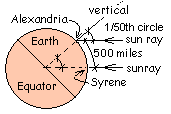| THERMO Spoken Here! ~ J. Pohl © | TOC NEXT ~ 5 |
Eratosthenes' Measures Earth
This experiment was conducted around 200BC.
Eratosthenes worked as a librarian in the great library of Alexandria, Egypt (~200 BC). Those were times of greatly increasing travel from East to West and back.

Knowing geometry and having observed eclipses of the moon, Eratosthanes came to believed Earth was a sphere. To measure its circumference, he devised a plan to used the rays of light form the sun. He assumed all rays from the sun arrived at Earth parallel, each to all others.
Use Eratosthenes' data (shown in the figure). Calculate the circum-ference of Earth he determined.
♦ Wells were common in Egypt. To dig straight down, a worker would place a plank across the well opening and at its center he would lower a mass attached to a string. By Earth's gravity, the mass hung straight down; the line of the string established a "vertical" at that geographic location.
The mass hung in one well at Syrene showed something special. At precisely noon on the solstices the shadow of that mass fell directly to the well bottom, in near-perfect alignment with the rays of sunlight. Look into the well one saw the full blinding reflection of rays of sunlight. Eratosthenes reasoned that this occurred because the rays of the sun struck Earth perpendicularly.
At Alexandria, approximately 500 miles due north of Syrene, sunlight did not pass directly to the well bottom. To measure the angle of incident sunlight Eratosthenes lowered a plumb bob suspended by a string into a deep well. The sketch shows the angle of the rays at Alexandria (zero degrees at noon on the say of summer solstice). Also depicted is the "1/50th of a circle" measured angle to Alexandria at noon on the same day.
 |
(1) The length of a radial arc equals its radius times the angle subtended (in radians). There are 2π radians in 360 degrees. |
We seek the radius (Earth's radius) associated with a circular arc length of 500 miles with the angle of arc subtended being 1/50 th of a full circle. Placing these numbers in the equation yields:
 |
(2)
Note: It is a waste of time and promotes a bad habit to "do algebra" to arrange rEarth left of the equality. Leave equations as they are. Insert relevant numbers until there is only one unknown entity (all other terms are numbers with units (~ as in Eqn. 2). Always "do algebra" as the last step, by putting the symbol of the unknown "left-of-equality" and the number (with units) right-of-equality. Finally, use the calculator to "find" the number. |
 |
(3) |
But the circumference of a sphere equals π times its diameter:
 |
(4) |
Today the measured radius of Earth is taken to be 3963 miles. Thus, supposing 3963 miles is the actual radius, the percent error of Eratosthenes' measurement was:
 |
(5)
The "sign" of this error is positive which means the value determined by Eratosthenes was greater than the present day, accepted value. |
Thus his measurement of the Earth circumference (some 2000 years ago) was in error: Less than actual by only one-tenth of a percent. Very close, indeed!
In closing, notice that Eratosthenes "made some measurements" then entered those measurements into an equation to obtain a second, grander measurement. This is a common technique of engineering and science.